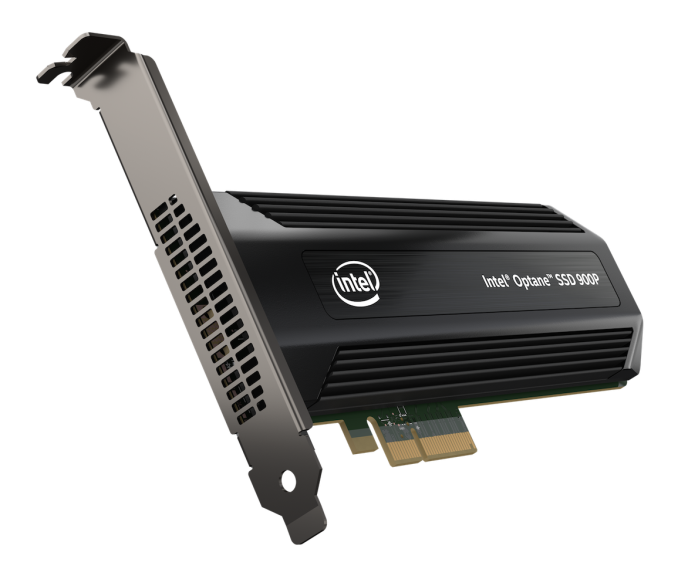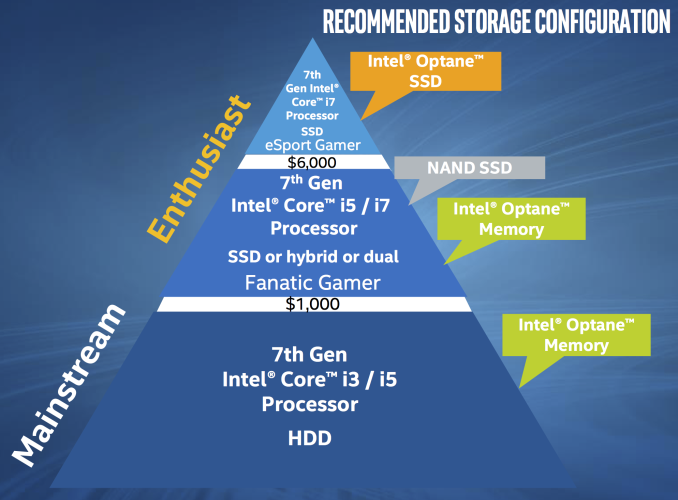The Intel Optane SSD 900P 280GB Review
by Billy Tallis on October 27, 2017 9:30 AM EST
Whenever Intel develops a new generation of SSDs based entirely on in-house technology, the result is usually a product that turns heads. Several times, Intel has set a new standard for SSD performance, starting with its original X25-M. Their most recent shake-up of the consumer SSD market was the Intel SSD 750, the first consumer NVMe SSD. Such significant releases don't happen every year, and in the intervening years Intel's competitors always catch up and surpass Intel.
However this year's revolution from Intel will be very hard for the competition to match anytime soon. All of Intel's previous record-setting SSDs have relied on the drive's controller to stand out from the crowd. This time, Intel's advantage comes from the storage medium: its 3D XPoint memory technology, a new nonvolatile memory that offers much higher performance than flash memory.
The Intel Optane SSD 900P
The new Intel Optane SSD 900P is a premium NVMe PCIe SSD offering the highest level of performance, with a moderate capacity. The Optane SSD 900P is intended for high-end desktop systems and workstations with very disk-heavy workloads. The Optane SSD 900P isn't for everyone and won't be displacing any existing products - it exists alone in a new product tier, with prices that are more than twice what the fastest flash memory based SSDs are selling for.
Optane is Intel's brand name for products featuring 3D XPoint memory. The Intel Optane SSD 900P is actually the third Optane product to be released, but it's the first family member to go after the high end consumer market segment. The Intel Optane Memory M.2 drives released earlier this year have capacities far too small for general-purpose storage use and instead have been marketed for use as a cache device to be paired with a mechanical hard drive. Intel's caching strategy works and can bring a hard drive's responsiveness up to the level of mainstream SSDs, but it has downsides. The Optane Memory caching requires a few extra steps to setup, and the caching software will only run on Intel platforms introduced this year: Kaby Lake or newer.
The Optane SSD DC P4800X is Intel's flagship enterprise SSD, and it is priced accordingly—putting it far out of reach of consumer budgets, and even with a price tag of over $1500 for 375GB it has been quite difficult to acquire. In the enterprise storage market, the P4800X has been highly sought after, but it isn't appropriate for all use cases and is not a threat to the many enterprise SSDs that prioritize capacity over performance and endurance.
The Optane SSD 900P will still cause some sticker shock for consumers expecting prices in line with M.2 PCIe SSDs, but it is acceptable for the kinds of machines that might be packing multiple GPUs or 10+ CPU cores. The Optane SSD 900P probably wouldn't be the only drive in such a system, but it would work well as a blazing fast primary storage device.
| Intel Optane SSD 900P Specifications | ||
| Capacity | 280 GB | 480 GB |
| Controller | Intel SLL3D | |
| Memory | Intel 128Gb 3D XPoint | |
| Interface | PCIe 3.0 x4 | |
| Form Factor | HHHL Add-in card or 2.5" 15mm U.2 |
HHHL Add-in card |
| Sequential Read | 2500 MB/s | |
| Sequential Write | 2000 MB/s | |
| Random Read IOPS | 550k | |
| Random Write IOPS | 500k | |
| Power Consumption | 8W Read 13W Write 14W Burst 5W Idle |
|
| Write Endurance | 10 DWPD | |
| Warranty | 5 years | |
| Recommended Price | $389 ($1.39/GB) | $599 ($1.25/GB) |
The Intel Optane SSD 900P is initially launching with 280GB and 480GB capacities. Both sizes will be available as PCIe 3.0 x4 half-height half-length add-in cards, and the 280GB model is also available as a 2.5" U.2 drive. Higher capacities may be added later, but Intel isn't promising anything yet. The sequential transfer speeds are nothing special for a NVMe SSD these days—Samsung's 960 PRO can hit much higher read speeds and slightly higher write speeds. The random read and write IOPS are far higher than any consumer SSD has offered before.
Intel's specifications for power consumption show one big reason why the Optane SSD 900P is a desktop-only product. Laptops are not equipped to supply up to 14W to a SSD, and they usually aren't equipped to cool a drive that idles at 5W instead of 50mW. The level of performance offered by the Optane SSD 900P cannot currently fit within the power budget or space constraints of a M.2 card.
The five year warranty Intel offers is typical for a high-end SSD in today's market, but doesn't compare to the 10 year warranty that Samsung's flagship 850 PRO SATA SSD offers. On the other hand, the 10 drive writes per day write endurance rating is far higher than most consumer SSDs get; 0.3 DWPD is more typical.
The Intel Optane SSD 900P starts shipping worldwide today, and here is our review of the 280GB version.











205 Comments
View All Comments
Nikijs - Monday, October 30, 2017 - link
pls anand. just kill ddriver acc. he ruins all comment section. he's maybe "smart", but lives in another dimension, where he thinks he is only one who understands something. i bet he never ever achieved something worthy in his life. thats where all hidden anger comes from.daremighty - Tuesday, October 31, 2017 - link
I don't agree that Anandtech's approach to measure random performance. QD1 random is directly reflect the latency of memory chip (NAND or 3D Xpoint). Between the queue, there should be some idle time and it didn't explain the real random performance of device. Under random workload, the device should handle multiple random requests - it means deeper QD is more natural to explain the random performance of QD. Probably, many device would require deep QD to saturate the random, but I think it is still valid metric. I think in random, random performance with deep (64 or 128?) QD is as much important as low QD (1/2/4?). Again, low QD is just shows the NAND performance, not SSD performance.rep_movsd - Tuesday, October 31, 2017 - link
Seems like the great ddriver is an expert in all things, and his opinions of "Hypetane" are based on solid fact and "decades" of experience (of bashing intel I guess).All the people who buy Intel are idiots and those who praise Intel technology are shills...
Meanwhile, Optane and similar technologies will eventually replace SSDs and ddriver will still be grumbling about how SLC would have been better if given a chance....
Get with the times - no one is forcing anyone to buy anything Intel - and if you think anandtech fudges benchmarks, put your money where your mouth is and try doing a fraction of what they do...
Don't pour cold water on others efforts just because you have some PTSD with Intel for whatever reason...
"Bullwinkle J Moose" - Tuesday, October 31, 2017 - link
"Get with the times"Thats a great comment!
Seems like ddriver might have gotten a timeout several days ago and yet a few of you can't seem to get over him
Just admit it, you loved his comments and want him back, or else you could get with the times and get over him
He's gone, but look at the bright side.....
I'M BACK!
rep_movsd - Wednesday, November 1, 2017 - link
Yes, I love him, like all trolls love other trollsmrhamdnloanoffer - Wednesday, November 1, 2017 - link
Do you have bad credit or in need of urgent loan to solve a pressing need? We lend secured and unsecured loans to honest and reliable individuals and companies globally at 3% interest rate. Here is the solution to your financial problem, do you also need money for your, project, business, taxes, bills, and many others reason, contact us today for that loan you desire, we can arrange any loan to suit your budget at low interest rate.Contact us
DocNo - Saturday, November 4, 2017 - link
Intel's caching software for Optane sucks - super finicky, not easy to integrate with an existing system and most of all requires specific motherboard to work (which I happened to have, but not the right partition layout - I dunno, technical documentation for what they want is pretty nonexistent).Luckily I stumbled PrimoCache. Downloaded a trial and had it working with my m2 Optane in 5 minutes. Made a noticeable and rather dramatic difference, even when loading stuff off of my Samsung EVO SSD. For $20 it was worth the frustration of not having to figure out Intel's poorly documented and overly fussy software. And if you don't have an Intel supported board, this lets you use Optane for caching with any board with an m2 slot.
These Optane drives would be awesome for servers - based on the experience with my desktop I now use PrimoCache on a couple of my servers and even with cheap SSDs the difference is amazing. With larger Optane drives? I should be even better. And at $120 for the server version it's by far the fastest way to add SSD caching to Windows Server. I'm extremely happy with it!
weevilone - Sunday, November 5, 2017 - link
That's interesting.. wish I had known about PrimoCache when I was tinkering with the little Optane stick. Intel's software was a huge mess, and Intel was less than helpful in working through it. When I finally went to remove it and throw in the towel, neither the software nor the UEFI could remove the stuff. I wound up having to reinstall Windows.Kwarkon - Monday, November 6, 2017 - link
I'm quite curious what exact issues you had, especially with disabling Optane?mattlach - Saturday, December 30, 2017 - link
Looking at that random 4k write performance, I'm thinking a pair of these would be absolutely fantastic as a mirrored SLOG/ZIL device for my massive ZFS pool. It's very tough to predict through.Question is how they would perform on the dual socket Westmere-EP Xeons powering my storage box, with only PCIe Gen2... Probably won't make a huge difference since the write speed peaks out at about 1.7GB/s and 4x PCIe Gen2 tops out at 2GB/s.
I wouldn't mind a decent boost to sync write speeds, and this 900p seems like its tailor made for the job. No cache, so there is no need for battery/capacitor backup, and very high speed, low latency random writes...